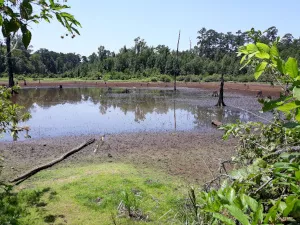As the 60th anniversary of the Wilderness Act and the 40th anniversary of the Texas Wilderness Act approaches, I want to introduce people to the five East Texas Wilderness Areas (ETWA) that are found in the National Forests and Grasslands in Texas (NFGT), Sam Houston, Davy Crockett, Angelina, and Sabine National Forests.

Big Slough Wilderness Area (BSWA) is our smallest wilderness area, 3,639 acres. It’s found in Davy Crockett National Forest (DCNF) and is the place to go if you like bottomland hardwood forests.
These bottomland hardwood forests contain Overcup Oak, Planer Tree, Green Ash, Buttonbush, Mayhaw, Cherrybark Oak, Sweetgum, Loblolly Pine, Swamp Chestnut Oak, River Birch, Black Willow, American Sycamore, American Elm, Bitternut Hickory, Cedar Elm, Sugarberry, Willow Oak, Bald Cypress, Black Gum, Water Hickory, Shagbark Hickory, American Basswood, and many other trees.
BSWA is the best example of a mature to old growth bottomland hardwood forest that I have seen in the NFGT. I consider any tree over 30 inches in diameter an old growth or near old growth tree. BSWA has an abundance of these large trees along with river-borne natural hydrology including tributaries (Hickory and Walnut Creeks), swales, depressions, sloughs, channels (both connected and abandoned), wetlands, flats, ponds, and other water moving and retaining geologic features.

Thanks to the Neches River, which forms the eastern boundary of BSWA, water and wind are the natural disturbances that shape the floodplain, slope, and upland forests in BSWA. Channel catfish and other fish make their home in Big Slough and the Neches River.
Many downed trees and snags (standing dead trees) are found in BSWA as part of an evolutionary play with ecological dramas that occur during every flood and or windstorm. Which trees live, die, or are wounded, decide and feed the soils, vegetation, and animals with organic and nutrient filled tree trunks and river sediment.

While most of BSWA is in the floodplain of the Neches River and its tributaries, the southern portion is part of the Sparta Sandhills and has an upland rise that grows Shortleaf and Loblolly Pine, Black Oak, White Oak, Post Oak, Allegheny Chinkapin, Southern Red Oak, Farkleberry, and Louisiana Yucca.
Access is by cross-country hiking or by the 4Cs Trail which crosses part of the BSWA in the mid to southern portions. You won’t have a better time hiking than a stroll through BSWA. Try it and I’ll bet you like it.
Photos by Brandt Mannchen.